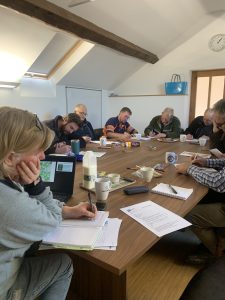
Workshops are being held with farmers and landowners in north Shropshire
Farmers are being encouraged to join the conversation and influence the Severn Valley Water Management Scheme’s (SVWMS) Perry and Peatlands Demonstrator Project in north Shropshire.
SVWMS, which comprises the Environment Agency, Natural Resources Wales, Powys County Council and Shropshire Council, is working with Shropshire Wildlife Trust (SWT) to develop a water management strategy focused on reducing flood risk and delivering broader benefits to the Severn catchment area and beyond.
The Perry and Peatlands Demonstrator Project, managed by Shropshire Council, focuses on implementing nature-based solutions to manage water flow and reduce flood risk by creating a series of interventions, such as floodplain reconnection and wetland creation, to slow the flow of water and enhance habitats.
Consultants Faulkner and Mayne have been supporting the North Shropshire Farmers Group and promoting the project.
Sarah Faulkner said:-
“Many farmers are already looking for water management solutions and ways of mitigating climate change.
“They can see the potential in water management and flood controls and recognise the opportunities open to them by getting involved and influencing the types of measures and landscape changes they believe will help in future flood risk reduction.
“We have hosted workshops over recent months and enjoyed some positive, open discussions which we are sure will help inform the Perry and Peatlands Demonstrator Project and bring some positive results.”
Rosie Morrant, who is leading the project on behalf of SWT, said:-
“The farmers of north Shropshire are very familiar with the impact of flooding on their land and many have already taken part in flood management schemes before.
“This project supports farmer led design of schemes, and is a great opportunity to bring their knowledge and insights into the future of flood management in the Severn catchment, starting with a close look at the landscape of the River Perry and its neighbouring catchments.
“Some of the farmer led suggestions that have already come forward include leaky wood barriers and field drain re-wiggling to slow the flow of water, and the creation of wetland scrapes or attenuation pools to tackle areas of surface water flooding. These natural flood management features also have an added biodiversity benefit. We are also supporting farmers to investigate solutions for wetter land management and green finance options for peatland rewetting.”
Subject to surveys, licensing agreements and seasonal restrictions the Perry and Peatlands Demonstrator Project will be looking to begin the practical work of floodplain reconnections and re-wetting of peatlands from August this year.
If you are a farmer or landowner and have ideas for water management or attenuation on your land then please email Sarah Faulkner at sarah@fmagri.co.uk
Future Perry and Peatlands workshops and events will be publicised via the North Shropshire Farmers Group – please contact Sarah Glazebrook-Milner sarah@thecountryoffice.co.uk to sign up to the mailing list.
About the SVWMS:
The SVWMS is led by a partnership of the Environment Agency, Natural Resources Wales, Shropshire Council and Powys County Council.
It has been developed in response to significant flooding of the River Severn in recent decades which has damaged homes and businesses, impacted local infrastructure and disrupted travel. This project aims to better protect over 3,000 homes and 1,000 businesses from flood risk across the upper Severn catchment in England and Wales.
The project also seeks to support the management of long-term water resources, with recent periods of prolonged dry weather having resulted in the need for action to minimise the environmental damage from low water flows. As an example of these extremes, in 2022 the Upper Severn catchment went from winter flooding to drought within the space of 8 months, with groundwater and reservoir stores being used to support the people and wildlife who depend on the water supply provided by the Severn.
To help address these issues, the SVWMS is adopting a regenerative approach, meaning that interventions will seek to positively contribute to addressing the climate crisis and halting biodiversity decline, whilst also providing significant flood risk benefits. It will investigate interventions including natural flood risk management measures that slow the flow of water upstream such as the creation of leaky dams and other land management practices, as well as engineered solutions such as the construction of flood storage areas and embankments.
